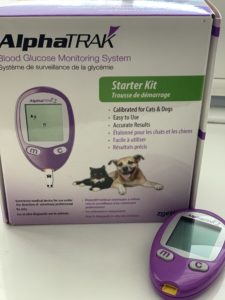Diabetes in Pets: Do You Know the Signs?
 November is American Diabetes Month®. Diabetes is not just a human disease; dogs and cats also suffer from this all too common disease. In fact, estimates report that diabetes affects about 1:200 cats and 1:300 dogs nationwide and it is increasing at an alarming rate. Fortunately, diabetes is a manageable condition in pets just like humans.
November is American Diabetes Month®. Diabetes is not just a human disease; dogs and cats also suffer from this all too common disease. In fact, estimates report that diabetes affects about 1:200 cats and 1:300 dogs nationwide and it is increasing at an alarming rate. Fortunately, diabetes is a manageable condition in pets just like humans.
WHAT IS DIABETES?
Diabetes mellitus occurs when the body is unable to regulate the amount of sugar in the bloodstream. Type 1 diabetes occurs when the body fails to produce the hormone insulin. Insulin is released when blood sugar levels are high and results in the transfer of sugar from the bloodstream into cells to be stored or used for energy. Insulin resistant or Type 2 diabetes develops when the body becomes less responsive to the effects of insulin. Both Type 1 and Type 2 diabetes result in chronically elevated levels of sugar in the blood that damage capillaries and eventually lead to nerve damage, kidney failure and even death. Type 2 diabetes is the most common form of diabetes seen in cats, while Type 1 diabetes is the most common form of diabetes in dogs.
WHAT CAUSES DIABETES?
Diabetes mellitus is a multifactorial disease influenced by both inherited and environmental factors. Genetic predisposition seems to be an important risk factor, and in dogs, certain breeds, like Keeshonds and Samoyeds, are more likely to develop diabetes. Age is another important risk factor. Though it can affect animals of any age, it is more common in middle-aged and older animals. However, of all the risk factors, obesity is the most important for Type 2 diabetes, especially since the prevalence of obesity is increasing. In the United States, it is estimated that 45% of dogs and 58% of cats are overweight.
SIGNS AND SYMPTOMS OF DIABETES
The classic symptoms of diabetes are increased thirst, increased appetite, and increased urination. In addition to these textbook symptoms, pets with diabetes may become lethargic, lose weight, have a dull coat, and in dogs, develop cataracts. It is important to be aware of the signs and symptoms of diabetes so that you can promptly seek veterinary care if you notice any of these in your pets. Of course, it’s important to mention that animals are very adept at hiding illness so these symptoms may be difficult to recognize initially. That’s why regular veterinary check-ups are so important. Annual examinations and diagnostic tests help to uncover diseases, like diabetes, early when they are typically easier to treat or manage.
HOW DO YOU KNOW IF YOUR PET HAS DIABETES?
If you think your cat or dog may have diabetes, see your veterinarian immediately. Diabetes is diagnosed by having your veterinarian perform simple blood and urine tests on your animal. These fast and easy diagnostic tests allow your veterinarian to detect abnormally high levels of sugar in your pet’s bloodstream and also look for the presence of sugar or sugar breakdown products in their urine.
TREATMENT
So what can be done? Fortunately, being diagnosed with diabetes is not a death sentence. Diabetes is a manageable disease. The goal of treatment is to provide stable blood sugar levels. This can be achieved with some combination of diet, insulin and at-home monitoring. There are several different types of insulin available with different durations of action, your veterinarian will assess your pet to determine which type of insulin will be best for your particular pet. In addition to insulin, diet and weight loss are just as important when it comes to treating diabetes in pets. Recent nutritional studies show that switching to a low-carbohydrate and high-protein canned food diet is the most effective dietary routine for most diabetic cats. Speak with our veterinarian about what if any nutritional changes are necessary for your particular pet. Weight loss is also important because obesity is a common cause of insulin resistance. Fatty tissue releases factors that impair the effects of insulin. To promote weight loss, you should exercise your pets in addition to following your veterinarian’s dietary suggestions. At-home monitoring makes a huge difference in the quality of life of pets with diabetes. Through proper veterinary care and the right at-home blood glucose monitor, calibrated specifically for dogs and cats, diabetes in pets can be successfully managed on an ongoing basis. For more information on at-home monitoring click here.
 TAKE HOME MESSAGE
TAKE HOME MESSAGE
Diabetes is an increasingly common problem in dogs and cats. Become familiar with the signs and symptoms of diabetes and watch for their development in your pet. Take your furry friend to their veterinarian for regular examinations and screening tests since it is best to catch diseases early before they become advanced and develop complications. If you discover that your animal has diabetes, remember diabetes is a manageable disease and with treatment most pets with diabetes can live long healthy lives.









